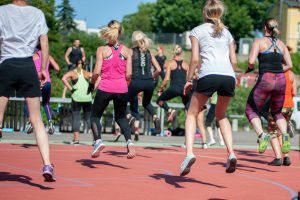Menopause, Health and Exercise:
How to Exercise for Menopause
As described Menopause, Health and Exercise menopause increases the risk of various health conditions, however, luckily for us exercise plays a significant role in managing these risks.
We’re going to share with you which exercises are the best, and why!
Caution: With the increased prevalence of health issues, it is important to have clearance from your GP to exercise. You should especially be aware of any underlying blood pressure issues or risks of low bone density.

Your Question:
What is the relationship between exercise, menopause and other health conditions?
Do you have any recommendations about how to manage the changes through lifestyle?
The Best Exercises
Jumping, jogging and dancing
Exercises that involve landing on the ground such as jogging, dancing, skip rope jumping, jumping on the spot without a rope and stomping upstairs. These are an effective way to increase bone strength as bones respond to the force going through them by getting stronger!
Increasing bone strength is important for menopausal women as estrogen plays a role in calcium regulation for the bones, therefore their bone density is often lower, placing them at risk of osteoporosis and fractures.
Strength training
As your upper body doesn’t hit the ground when you’re running your arm bones aren’t getting any benefit from all the jumping and jogging!
So, strength exercises like pulldowns and pushing are effective for upper body bones!
Strength training also reinforces muscle, therefore reversing and slowing the diminishing of our muscles, which naturally occurs with ageing. Having more muscle helps manage blood sugar levels as well as keep your resting metabolic rate up a little higher.
Caution: If you do have low bone strength heavy weights may cause a fracture. Sometimes muscles can be stronger than bones, so if you’re new to strength training, ease into it!
Aerobic Exercise
Menopause promotes fat storage around the waist which places extra pressure on the organs. Menopause is also associated with altered cardiovascular health through the impaired nervous system and no longer receiving the protective benefits estrogen has on the blood vessels.
So aerobic exercise is pretty important! It helps to maintain blood vessel, heart and lung health, improve blood cholesterol and assist in body weight management – all powerful against disease onset!
Aerobic exercise can be anything you enjoy that gets your heart rate and breathing up!
Pelvic Floor and Core
The decreased estrogen levels cause thinning of the urethra which leads to incontinence. Pelvic floor exercises can be helpful here. It’s best to see an exercise physiologist, physiotherapist or pilates instructor specialising in Womens’ health.

How Much Exercise?
Menopause does not change the amount of exercise an individual should be performing. The minimum amount of physical activity anyone should achieve is:
- 150 minutes of moderate intensity aerobic activity or 90 minutes of high intensity activity per week (30 minutes most days)
- 2-3 strength training sessions per week
- 7,000 steps per day (not including the above exercise)
That said, 60 minutes of exercise per day has been shown to be superior to decrease the effects of age-related weight gain.
Achieving the recommended amount decreases the risk of developing cardiometabolic diseases and cancers.
Other Lifestyle Interventions
There are other lifestyle practises you should consider in the management of menopause symptoms and side effects. These include:
- Diet – have a balanced diet with minimal sugary foods to assist in weight management, blood sugar and blood cholesterol levels, as well as inflammation
- Caffeine – Caffeine can exacerbate hot flushes as well as decrease the absorption of calcium and other nutrients
- Smoking – further increases the risk of osteoporosis and heart disease
- Sleep hygiene – to help pain, fatigue and mood management
- Social support – coping with the menopause can be harder due to the social circumstances are in, particularly if their adjustments to family or work life which are often common at this age
- Stress management – to assist pain, mood, fatigue and menopausal symptoms
Menopause and Rehab
And because we’re are rehab company…
Treating providers should be aware of the symptoms and side effects of menopause especially fatigue, pain and the extra risks exercise may pose as this will affect their rehab!

Each month we will pick a question to Q&A.
Send your questions to brad@specialisedhealth.com.au or biara@specialisedhealth.com.au
Or contact us through the below social media outlets!
References
- M Hickey & E Banks (2016), NICE guidelines on the menopause, missing quantitative summary estimates of risks of hormone therapy, BMJ, doi: 10.1136/bmj.i191
- A Park (2011), The Hot Flashes of Menopause May Protect Women’s Hearts, Time Magazine http://healthland.time.com/2011/02/24/the-hot-flashes-of-menopause-may-protect-womens-hearts/?fbclid=IwAR0UFWRnpKDa7J4d7AFTHFsyxguDUCu24PAH_8NfCwRKigOQd1qXM7yu67E
- Marpaung, et al. (2019), Hormone Examination in Menopause¸ Indonesian Journal of Clinical Pathology and Medical Laboratory, 25 (2) : 233 – 239
- B Sternfeld & S Dungan (2011), Physical activity and health during the menopausal transition, Obstet Gynecol Clin North Am, 38(3): 537–566. doi:10.1016/j.ogc.2011.05.008.
- C Lyon et al., (2018), Does exercise relieve vasomotor menopausal symptoms?, The Journal of Family Practise, MDEDGE.COM/JFPONLINE
- A Capozzi & S Lello (2018), Short focus on thyroid function in menopause: impact on bone health, Clinical Cases in Mineral and Bone Metabolism, DOI: 10.11138/ccmbm/2018.15.2.209

Biara Webster
Exercise Physiologist and Writer/Content Manager






